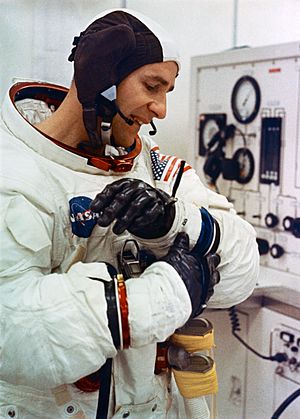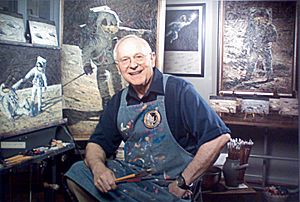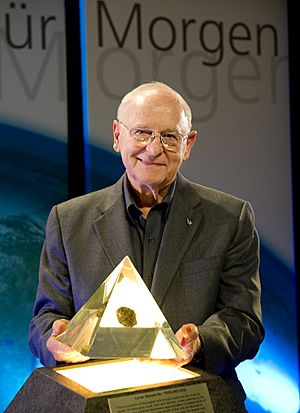Alan Bean facts for kids
Quick facts for kids
Alan Bean
|
|
|---|---|
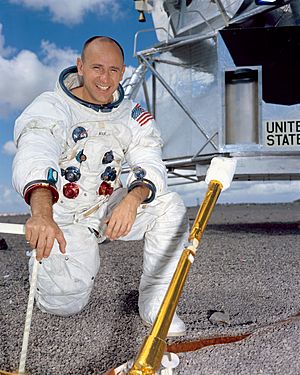 |
|
| Born |
Alan LaVern Bean
March 15, 1932 Wheeler, Texas, U.S.
|
| Died | May 26, 2018 (aged 86) |
| Resting place | Arlington National Cemetery |
| Alma mater | University of Texas at Austin (BS, 1955) |
| Occupation | |
| Awards | NASA Distinguished Service Medal |
| Space career | |
| NASA Astronaut | |
| Rank | |
|
Time in space
|
69d 15h 45min |
| Selection | 1963 NASA Group 3 |
|
Total EVAs
|
3 |
|
Total EVA time
|
10 hours 12 minutes |
| Missions |
|
|
Mission insignia
|
  |
| Retirement | June 1981 |
Alan LaVern Bean (born March 15, 1932 – died May 26, 2018) was an American naval officer and pilot. He was also an engineer, test pilot, NASA astronaut, and painter. NASA chose him to be an astronaut in 1963. He was the fourth person ever to walk on the Moon.
Before becoming an astronaut, Alan Bean studied Aeronautical Engineering. He earned his degree from the University of Texas at Austin in 1955. After that, he rejoined the U.S. Navy. He had served in the Navy for a year right after high school. In 1956, he became a naval aviator, flying fighter jets. He also trained as a test pilot.
His first trip to space was on Apollo 12 in November 1969. This was the second mission where people landed on the Moon. He was 37 years old at the time. His second and last space flight was on the Skylab 3 mission in 1973. This mission went to the Skylab space station. After leaving the Navy in 1975 and NASA in 1981, he became a full-time painter. He painted scenes from space, including his own experiences. He was the last living crew member from the Apollo 12 mission.
Contents
Biography
Early Life and Education
Alan Bean was born on March 15, 1932, in Wheeler, Texas. His parents were Arnold Horace Bean and Frances Caroline Bean. He grew up mostly in Fort Worth, Texas. As a boy, he lived in Minden, Louisiana, where his father worked.
Alan was a Boy Scout and reached the rank of First Class. He finished high school in Fort Worth in 1949. After high school, he joined the U.S. Naval Reserve.
He earned a degree in aeronautical engineering from the University of Texas at Austin in 1955. He attended college with a Navy scholarship.
Military Service
In 1955, Alan Bean became an ensign in the United States Navy. He then started flight training. By 1956, he was flying F9F Cougar and A4D Skyhawk jets.
He later attended the U.S. Naval Test Pilot School. His instructor there was Pete Conrad, who would later be his commander on Apollo 12. Bean also took art classes during this time. He worked as a test pilot for many different Navy planes.
Alan Bean flew for more than 7,145 hours in his career. About 4,890 of those hours were in jet aircraft.
NASA Career
NASA chose Alan Bean to be an astronaut in 1963. He was part of Astronaut Group 3. He was a backup pilot for Gemini 10. He also helped test new ways to train astronauts. He was the first astronaut to train in the Neutral Buoyancy Simulator. This is a large pool that helps astronauts practice moving in space.
When another astronaut, Clifton Williams, died, Alan Bean got a chance. Apollo 12 Commander Pete Conrad asked for Bean to join his crew.
Apollo Program
Alan Bean was the pilot of the Apollo Lunar Module on Apollo 12. This was the second mission to land on the Moon. In November 1969, Bean and Pete Conrad landed in the Ocean of Storms. Their journey was 250,000 miles long. The rocket was even hit by lightning during launch!
Bean helped save the mission after the lightning strike. He followed instructions to fix the spacecraft's systems. On the Moon, they explored the surface. They set up experiments and the first nuclear power station there. Dick Gordon stayed in orbit around the Moon. He took pictures of future landing spots.
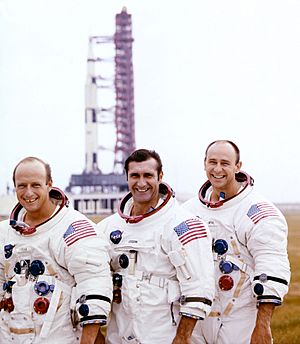
Bean wanted to take a special photo on the Moon. He planned to use a self-timer to photograph both himself and Pete Conrad. This would have been near the Surveyor III spacecraft. But they couldn't find the timer in their tool bag. He later found it when it was too late to use. He threw it away in frustration. He later painted what that photo would have looked like. He also painted about searching for the timer.
You can see Alan Bean's space suit at the National Air and Space Museum.
Skylab
Alan Bean was the commander of Skylab 3. This was the second mission with a crew to the Skylab space station. It lasted from July 29 to September 25, 1973. His crew included Owen Garriott and Jack R. Lousma.
Bean and his crew stayed on Skylab for 59 days. They traveled a record-setting 24.4 million miles. During the mission, Bean tested a new flying machine called the Manned Maneuvering Unit. He also did one spacewalk outside Skylab. The crew completed 150% of their mission goals.
Post-NASA Career
After Skylab, Bean was a backup commander for the Apollo-Soyuz Test Project. This was a joint mission between America and Russia.
He retired from the Navy in 1975 as a captain. He then continued to work for NASA as a civilian. He led the group that trained new astronauts.
Alan Bean spent 1,671 hours and 45 minutes in space. He spent 10 hours and 26 minutes on spacewalks. These spacewalks were on the Moon and in Earth orbit.
Painting
Alan Bean left NASA in June 1981 to focus on painting. He said he wanted to paint because he had seen things no other artist had. He wanted to share his space experiences through his art.
As a painter, Bean wanted to add color to the Moon. He said, "If I were a scientist painting the Moon, I would paint it gray. I'm an artist, so I can add colors to the Moon." So, in his paintings, the Moon is not just gray. It has shades of many colors.
Bean's paintings include Lunar Grand Prix and Rock and Roll on the Ocean of Storms. He even used real Moon dust in his art! He found that patches from his space suit had Moon dust on them. He added tiny pieces of these patches to his paintings. This made them very special. He also used a hammer and a bronzed Moon boot to add texture to his paintings.
In July 2009, his Moon paintings were shown at the Smithsonian Institution's National Air and Space Museum. This was for the 40th anniversary of the Apollo 11 Moon landing.
Personal Life and Death
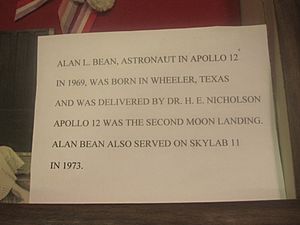
Alan Bean took a piece of his family's Clan MacBean tartan fabric to the Moon.
He married Sue Ragsdale in 1955. They had a son, Clay, and a daughter, Amy Sue.
Alan Bean died on May 26, 2018, in Houston, Texas. He was 86 years old. He became ill suddenly two weeks before his death. At the time, he was married to his second wife, Leslie. He was also survived by his sister, Paula Scott.
He was buried at Arlington National Cemetery on November 8, 2018.
Legacy
Alan Bean received many awards during his career. These include the Rear Admiral William S. Parsons Award for Scientific and Technical Progress. He also received the Godfrey L. Cabot Award in 1970.
He earned the Navy Astronaut Wings. He also received the Navy Distinguished Service Medal twice. He got the NASA Distinguished Service Medal twice as well.
Bean was added to the International Space Hall of Fame in 1983. He joined the U.S. Astronaut Hall of Fame in 1997. He was also inducted into the National Aviation Hall of Fame in 2010.
The University of Texas gave him the Distinguished Alumnus Award in 1970. He was the first Texan to walk on the Moon. The Texas Press Association named him Texan of the Year in 1969. In 2019, a spacecraft for the NG-12 mission was named the S.S. Alan Bean in his honor.
In Media
In the 1998 HBO miniseries From the Earth to the Moon, Dave Foley played Alan Bean. The Swedish artist Stina Nordenstam has a song called "The Return of Alan Bean." The British band Hefner also released a song called "Alan Bean" in 2001. For her 2019 novel, America Was Hard to Find, writer Kathleen Alcott based her description of the Apollo landing on interviews with Bean.
Books
- My Life As An Astronaut (1989) ISBN: 978-0671674250
- Apollo: An Eyewitness Account (with Andrew Chaikin) (1998) ISBN: 978-0867130508
- Into the Sunlit Splendor: The Aviation Art of William S. Phillips (with Ann Cooper, Charles S. Cooper and Wilson Hurley) (2005) ISBN: 978-0867130935
- Mission Control, This is Apollo: The Story of the First Voyages to the Moon (with Andrew Chaikin) (2009) ISBN: 978-0670011568
- Painting Apollo: First Artist on Another World (2009) ISBN: 978-1588342645
Bean's diary from his Skylab flight is in the book Homesteading Space: the Skylab Story.
See also
 In Spanish: Alan L. Bean para niños
In Spanish: Alan L. Bean para niños


